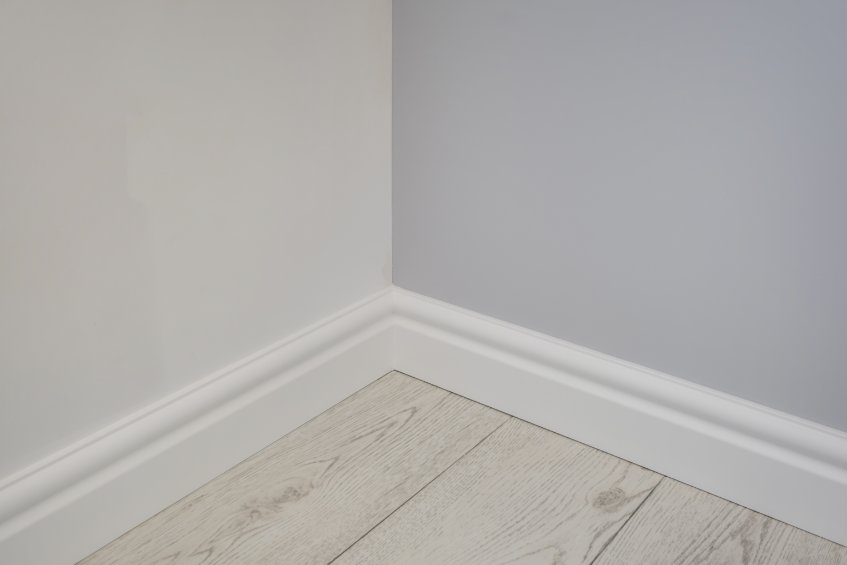Painting baseboards is a great way to spruce up any room, because baseboards receive a lot more “wear and tear” than other trim. In fact, the fastest way to upgrade the look of any home is to paint walls and baseboards together. The pros at Colortouch Painting recommend using a high quality water-borne acrylic or hybrid-alkyd paint because it will stick well, level well and is easy to clean up.
How To Paint Baseboards Already In Place
How you paint baseboards is determined largely if they are already on the wall or not. If you’re installing new baseboards the task is much simpler. They can be primed and painted before installation, then afterwards, one can touch up the nail-holes and caulk without coming close to the floor.

Step 1: Clean Baseboards Before Painting
Baseboards that have been in place for any length of time can get quite dirty. Dirt, dust and other grime can build over time and prevent paint from adhering to the surface. So we always recommend cleaning baseboards with a tsp (trisodium phosphate) “no-rinse” substitute before painting or priming. No-rinse substitutes work great without the caustic properties and rinsing of a conventional TSP, yet we advise a drop cloth to protect any vulnerable surfaces and always wear rubber gloves. In addition, use some form of eye protection to prevent any unwanted splashing in the eyes. Mix the TSP no-rinse with water per the instructions and use a clean rag to wipe down the baseboards. Be sure to get the top of the baseboards where dust has accumulated.
Step 2: Prepare Baseboard Surfaces
Most baseboards will have accumulated a number of battle scars over the years including scratches, dings or chips. Use wood filler such as bondo and a putty knife to fill in any problem areas, taking care to not over apply. To much filler just requires more sanding! Once the filler has dried, sand the surface using a 120 grit sandpaper.
Step 3: Masking
When it comes to baseboards, we always advise masking where the baseboards meet the floor to protect them from spatter. However, do not paint down onto the tape, as the paint will invariably “bleed” under the tape and onto the floor. Use a low-stick (blue) painters tape that’s between 1.5 and 2 inches wide. Apply it carefully and be sure to press firmly all along the length of the tape to minimize bleed-through. Remember, painters tape isn’t perfect no matter how well it’s applied so you still want to be careful when painting.
Step 4: Priming The Baseboards
If your baseboards don’t have a primer coat or are particularly old, a primer coat could be in order. If the baseboards are in good shape, you could probably skip this step. Apply primer carefully, so as not to load up too much primer to avoid any drips or runs. We recommend starting higher up on the baseboard and then slowly working the primer closer to the floor. If you start close to the floor, your primer is likely to bleed down onto (and under) the tape! Use long strokes starting near the top of the baseboard and don’t over apply. Then let the primer dry according to the manufacturers recommendations.
Step 5: Painting The Baseboards
First things first. If your paint has been sitting unused for more than a few days, be sure to give it a good stir before you start painting. It may also be a good idea to strain the paint, using a strainer bag and gloves.
Once your paint is ready to go, follow the same procedure as you did for the primer. Again, don’t overload your brush with paint so as to avoid drips and runs. One third of the bristle length should be enough. Use long strokes without over extending yourself so you maintain control on the brush. As you progress along the baseboard, keep a wet edge, painting back over the edges of previously painted areas before the paint dries. This helps prevent lap marks.
After the first coat has been applied, let the paint dry for 3-5 hours, depending on the room temperature. Paint dries better under warm conditions. Once it’s dry, apply a second coat and let the paint dry before removing the masking tape.
Professionals Painting Baseboards
A professional from Color Touch Painting of San Ramon shows off his skill painting baseboards. See the video captured by our client when we work on a painting project for his house in Blackhawk.

